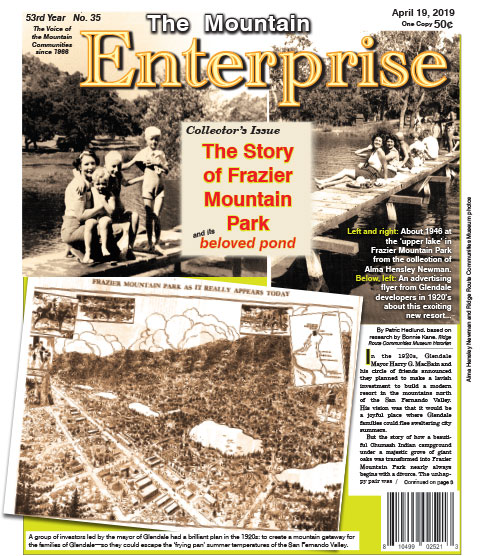By Patric Hedlund, TME
The 240,000 stunning acres of diverse landscapes managed by the nonprofit Tejon Ranch Conservancy are the superstar of Tejon Ranch Company’s national public relations and marketing campaigns.
Known as “TRC” on the New York Stock Exchange, Tejon Ranch Company’s goal is to build 34,783 new homes, scattered across three developments, that could bring 104,000 new people and millions of square feet of commercial activity to the Interstate 5 corridor known as the Grapevine.
That steep canyon passage used by 100,000 vehicles a day is also this sleepy Mountain Community’s front porch.
TRC’s progress toward fulfilling its corporate dreams has become a local slow-motion spectator sport. Now the plot is thickening in this long saga.
The Center for Biological Diversity (CBD) sent a letter last week to Los Angeles County Supervisors, asking that they reverse their vote to greenlight Centennial (TRC’s planned community to be built in Gorman, extending through the Western Antelope Valley to Neenach).
The letter signed by CBD attorney J.P. Rose pointed to a major change in the assurances the developer has made for 11 years in environmental impact reports submitted to Kern and Los Angeles Counties, required by California’s Environmental Quality Act (CEQA).
Bob Reid, CEO of Tejon Ranch Conservancy, resigned in an announcement last month. He said the conservancy staff is now cut in half due to lack of funds.
Stripped down to a skeleton crew, core research personnel have been laid off. There is no dependable income stream in sight for the group that is charged with managing the 178,000 acres of conserved land and wildlife corridors.
But this is the mitigation measure at the heart of three major environmental impact reports. In its EIRs for Tejon Mountain Village (3,450 homes), Grapevine Village (12,000 homes), and Centennial (19,333 homes), Tejon Ranch promised to conserve 178,000 acres of the ranch.
The Promise
Under terms of the 2008-2009 contracts signed with “Big Green” environmental groups at the unveiling of the Ranch-Wide Management Agreement, the developer agreed to provide funding for conservancy operations until 2021, in a loan agreement.
That was to be paid back once Tejon Mountain Village lots in Lebec began to sell, a project that got the green light from Kern County in 2009.
A small surcharge on the sale of each residential lot was intended to provide an ongoing income stream to support the conservancy. But 10 years later, no residential lots have yet been sold. None.
In his public resignation statement, Bob Reid blamed California’s 2008 recession.
It is true that collapse of real estate and capital markets 10 years ago may have delayed building the 3,450-home Tejon Mountain Village resort, thus starving the conservancy of independent funding.
$15.8 Million Pure Profit
In 2010 the conservancy’s nonprofit status was used as a pass-through device to convey $15.8 million from the taxpayers of California to the for-profit Tejon Ranch Company.
The California Wildlife Conservation Board made the grant to the conservancy to acquire 62,000 acres of conservation easements on the ranch to maintain open wildlife corridors between habitats. The conservancy had to hand the money directly to the developer. The windfall made Tejon Ranch Company’s TRC stock price soar on the New York Stock Exchange.
Tejon Ranch Conservancy was given the responsibility to manage that land along with the original 178,000 acres.
Erecting permanent structures on easement land is forbidden, but the ranch is allowed to continue using it for profitable agriculture, mining, grazing and exclusive commercial hunting operations.
Begging For Dollars
Now, nine years later, it appears the ranchwide agreement could be in jeopardy if the conservancy is running out of funding, and out of qualified personnel. Remaining personnel at the conservancy’s office in Lebec are publishing public outreach appeals, begging for dollars.
They need to find a way to create an endowment fund that will allow them to continue responsibly managing the combined 240,000 acres of preserved habitat.
Compromised Reputation
The conservancy’s good reputation as an independent research site with integrity worthy of winning major research grants took a blow last year. The event appeared to have been engineered by Tejon Ranch Company management.
During the public CEQA comment process for the Centennial development plan, free speech was stifled when Tejon Ranch corporate executives banned research scientists from coming on the conservancy property if the scientists’ reported discoveries that did not support Tejon Ranch Company’s development plans.
Tejon Ranch employees ordered supposedly-independent conservancy staff to dis-invite their own scientific colleagues from conservancy dinners and research projects.
The Mountain Enterprise documented and published in 2018 that Tejon Ranch Conservancy personnel were given orders by a TRC employee who was a member of the conservancy’s board of directors.
We reported that dozens of researchers, including Nick Jensen, Ph.D. of the California Native Plant Society were told they could no longer set foot on Tejon Ranch.
They’d been blacklisted
What were Jensen’s and his fellow researchers’ crimes?
They had published and discussed in public their research that showed that bringing 57,000 people to live in these northern Los Angeles County grasslands—stretching from the rolling hills of Gorman, past Quail Lake to Neenach—would harm one of California’s last and most unique contiguous grasslands. This is the area drawing worldwide attention this month for its stunning wildflower superbloom.
Kathleen Weinstein and other Mountain Community neighbors (all potential donors to the conservancy), were also banned from visiting and volunteering on conservancy lands if they spoke up publicly to question details of TRC’s development plans, or participated openly in the public CEQA hearing and comment process. The actual intent of the public CEQA process is to explore facts and to engage in open dialogue in a public process to inform legislators about the impact of proposed developments on the environment.
Push-Back
The Center for Biological Diversity’s letter told L.A. County Supervisors that “The county can’t expect an organization facing serious financial problems to manage thousands of acres of open space for conservation and public access. These lands need to be managed by an independent and adequately funded state agency to protect their beauty and immense ecological value.”
CBD also said the Santa Monica Mountains Conservancy, an independent state agency, and county planning commissioner Laura Shell have requested that the Tejon Ranch lands be managed by an independent public entity. Tejon Ranch Company has refused.
Attorney J.P. Rose added that County supervisors have not required independent management despite having authority to do so.
He said the 2008 agreement transfers “all costs and liabilities” relating to conservation activities and public access from Tejon Ranch Company to the Conservancy, but Tejon Ranch Company still “retains control over who can access conservation lands” and has the practice of banning scientists and community members.
“The company shouldn’t be able to have it both ways, by taking money from the public and then banning the public from accessing these lands,” said Nick Jensen, a Southern California conservation analyst at the California Native Plant Society.
“And L.A. County shouldn’t condone the company’s plan to shift mitigation costs onto a nearly insolvent conservancy while the company and its Wall Street investors make millions,” Jensen said.
The letter said the development would destroy thousands of acres of rare wildflower fields and add 75,000 new vehicle trips to already crowded freeways.
Photo captions:
Above: Governor Arnold Schwarzenegger blesses the ‘green deal’ that formed the creation of Tejon Ranch Conservancy in 2008. At right: TRC CEO Bob Stine gives a friendly greeting to Center for Biological Diversity lawyer Adam Keats in 2009.
To see full stories with photos, please purchase a copy of the newspaper at many locations (click this link for a list) throughout the Mountain Communities.
Or, have your newspaper delivered via mail and include internet access. Just call 661-245-3794. Classified ads are FREE to paid subscribers! See front page at www.mountainenterprise.com for details.
The e-Edition is available now with full photos and stories at The Mountain Enterprise e-Edition. Select the 2019-0412 edition.
(subscriber login required)
This is part of the April 19, 2019 online edition of The Mountain Enterprise.
Have an opinion on this matter? We'd like to hear from you.

![[photo by Chuck Noble]](https://mountainenterprise.com/wp-content/uploads/TejonRanch-ChuckNoble-web-324x192.jpg)

